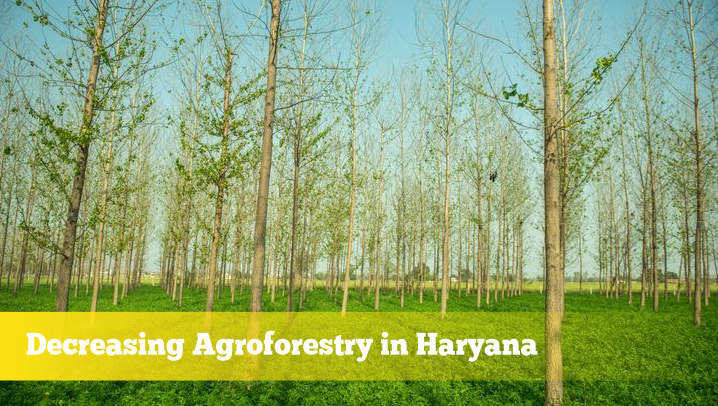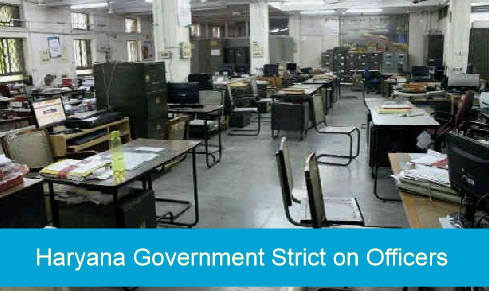
Decreasing Agroforestry in Haryana
- December 29, 2021
- 0
The area of wood is decreasing rapidly in Haryana, farmers are less interested in agroforestry.
In Haryana, the interest of farmers towards agroforestry is decreasing rapidly. This can have a huge impact on wood, plywood and the environment in the coming times. Experts say that agroforestry has been facing the apathy of the government for a long time. The farmers are not getting the reasonable price of wood and the fluctuation in the price is also one of the reasons, due to which the farmers are avoiding the cultivation of wood.
Experts say that this is not a good situation. For this plywood industry, government and farmers all should come on one platform. Because the cultivation of wood is not only necessary for the economic strength of the farmers, but it also strengthens the plywood industry of the state.
Keeping in mind the economic strength of farmers, the government had promoted agroforestry. In agroforestry, along with the cultivation of crops, wood is also grown. In this way the farmer can earn a substantial income by doing double farming. On this concept the cultivation of Safeda and Poplar was promoted in Haryana. But the way wood prices have been fluctuating for quite some time, the interest of farmers towards agroforestry is decreasing.
Poplar cultivation in Haryana has decreased by more than 40 percent in the last two years. Now when the time of planting poplar is going on, farmers are not taking much interest in its plantation. Farmers say that while cultivating Poplar and Safeda, then in the field where Safeda is planted, the crop can be grown only in the first year itself. No crop for the rest of the year. Wheat can be cultivated with Poplar regularly. However the production remains low. Now if the price of wood also goes down, then they go into heavy losses.
Pramod Chauhan, a wood producer from Haryana, told that the problem is that it takes four to five years to produce wood. After this, if the price is not attractive, then the farmer will be ruined. Price of lumber is not guaranteed. Buyers of wood create so many obstacles. Because of this, farmers are now less eager towards wood cultivation. Another farmer Karandeep Singh said that the rate is a big problem. There is lots of up and down in it. The market is completely in the hands of the buyer. Its ups and downs are in their hands. Therefore, the farmer does not get the full remuneration of their hard work.
The industrialist confirms that the point of the farmers is right, but the cost of raw material has increased so much that they are unable to give more price to the farmer for the wood.**** The plywood market is going down continuously. Industrialists are not able to increase the price of plywood. The competition has become so much that if one factory rises its price, the other is ready to sell the goods at a lower price. How can farmers get a fixed price for wood in such circumstances?
However, there was also an idea that like other crops, there should be a minimum support price for wood. Plywood industry reject this idea outright. They say that it is not possible. Because if the MSP is done, then the plywood manufacturer will have to buy all kinds of wood. Which is not fair. This will harm the industry. Even the government is advocating for selling the crop in the open market instead of MSP. Then how can industrialists guarantee MSP?
Experts also agree with this. So the question arises, what can be the solution to this problem? Experts say that there can be two options for this. Firstly, the way the government has started Bhavantar scheme for potato, onion, tomato etc. Under this scheme, a rate of vegetable has been fixed by the government. If that vegetable is now sold in the market at less than this rate, then the government fulfills the gap in the rate. For this, farmers have to register the crop by paying a minimum fee.
This can also be done in wood. The problem is that the government has to come forward for this. Because without government support this is not possible. Second, the plywood industry will also have to take initiative for this.
Another option could be that farmers and plywood industrialists as well as wood experts come on one platform. The availability and demand of wood should be assessed. After this the farmers should grow wood, with the help or support of the industry. This experiment is the same, which was done by Wimco long ago in the early stages of poplar cultivation. Wimco used to give popular trees to the farmers, with a guarantee to buy wood from them at a fixed price.
It can also be further improved that industrialists provide high quality wood seedings to the farmers. Medicines etc. are also made available from time to time. This work can be done either individually or in Corporate Social Responsibility. There should be a provision from the government that whatever industrialist is doing, there should be some relief in his tax. So that there is no financial burden on that unit.
Rohit, a student of MSc Agriculture, told that the cultivation of wood is not just a matter of farmer and industrialist, the way the issue of environment is arising, the utility of wood farming also increases in it. There is not enough land for forests. Green cover is decreasing rapidly. Farming is the only solution left. If agroforestry is done in the fields, then many problems can be overcome at once. So the government should also pay attention. Because the more green cover there is in the fields, less pollution will be there.
Manoj Thakur
हरियाणा में तेजी से कम हो रहा लकड़ी का रकबा, किसानों की एग्रोफोरेस्ट्री में रूचि भी घटी
हरियाणा में एग्रोफोरेस्ट्री के प्रति किसानों का रुझान तेजी से कम हो रहा है। इसका व्यापक असर लकड़ी, प्लाइवुड और पर्यावरण भी आने वाले वक्त में पड़ सकता है। विशेषज्ञों का कहना है कि लंबे समय से एग्रोफोरेस्ट्री क्योंकि सरकार की बेरुखी का सामना कर रहा है। किसानों को लकड़ी के वाजिब दाम न मिलने और दाम में उतार चढ़ाव भी एक वजह है, जिससे किसान लकड़ी की खेती से बच रहे हैं।
विशेषज्ञ कहते हैं कि यह स्थिति ठीक नहीं है। इसके लिए प्लाईवुड इंडस्ट्री, सरकार और किसान सभी को एक मंच पर आना चाहिए। क्योंकि लकड़ी की खेती न सिर्फ किसानों की आर्थिक मजबूती के लिए जरूरी है, बल्कि इससे प्रदेश के प्लाईवुड उद्योग को भी मजबूती मिलती है।
किसानों को आर्थिक मजबूती मिले,इसी को ध्यान में रख कर सरकार ने एग्रोफोरेस्ट्री को बढ़ावा दिया था। एग्रोफोरेस्ट्री में फसल की खेती के साथ साथ लकड़ी भी उगाई जाती है। इस तरह से किसान दोहरी खेती कर अच्छी खासी आमदनी कमा सकता है। इसी कांसेप्ट पर हरियाणा में सफेदा और पोपलर की खेती को बढ़ावा मिला था। लेकिन पिछले कुछ समय से जिस तरह से लकड़ी के दामों में उतार चढ़ाव हो रहा है, इससे किसानों का एग्रोफोरेस्ट्री के प्रति रुझान कम हो रहा है।
पिछले दो सालों में तो हरियाणा में पोपलर की खेती 40 प्रतिशत से भी कम हो गई है। इस बार अब पोपलर की रोपाई का समय चल रहा है, लेकिन किसान इसकी रोपाई में ज्यादा रुचि नहीं ले रहे हैं। किसानों का कहना है कि पोपलर और सफेदा के साथ जब वह खेती करते हैं तो सफेदा जिस खेत में लगाया जाता है, वहां तो पहले साल ही फसल हो पाती है। बाकी के साल कुछ नहीं हो पाता। पोपलर के साथ गेहूं की खेती हो सकती है। लेकिन उत्पादन कम रहता है। अब यदि लकड़ी का दाम भी कम हो जाए तो वह भारी नुकसान में चले जाते हैं।
हरियाणा के लकड़ी उत्पादक किसान प्रमोद चैहान ने बताया कि दिक्कत यह है कि चार या पांच साल लकड़ी पैदा करने में लगते है। इसके बाद यदि भाव न मिले तो किसान तो तबाह हो जाएगा। लकड़ी के दाम की गारंटी नहीं है। लकड़ी खरीदने वाले कई तरह की समस्या पैदा करते हैं। इस वजह से किसान लकड़ी की खेती की ओर अब कम जा रहे हैं। एक अन्य किसान करणदीप सिंह ने बताया कि रेट बड़ी समस्या है। इसमें उतार चढ़ाव बहुत ज्यादा है। मार्केट पूरी तरह से खरीददार के हाथ में है। इसका उतार चढ़ाव उनके हाथ में हैं। इसलिए किसान को मेहनत का पूरा पैसा नहीं मिल पाता।
इधर इंडस्ट्रियलिस्ट का कहना है किसानों की बात तो सही है, लेकिन कच्चे माल की लागत इतनी बढ़ गई कि वह कैसे किसान को लकड़ी का ज्यादा दाम दें इधर प्लाईवुड मार्केट लगातार डाउन जा रहा है। इंडस्ट्रियलिस्ट चाह कर भी दाम बढ़ा नहीं पा रहे हैं। प्रतिस्पर्धा इतनी ज्यादा हो गई कि यदि एक दाम बढ़ाता है तो दूसरा कम दाम पर माल बेचने को तैयार है। इस तरह के माहौल में कैसे किसानों को लकड़ी का निश्चित दाम मिल सकता है।
हालांकि एक यह भी विचार आया था कि दूसरी फसलों की तरह लकड़ी का भी न्यूनतम समर्थन मूल्य होना चाहिए। इस विचार को प्लाइवुड उद्योग संचालक सिरे से नकारते है। उनका कहना है कि यह संभव नहीं है। क्योंकि यदि एमएसपी हो जाता है तो प्लाईवुड निर्माता को तो हर ग्रेड की लकड़ी खरीदनी पडे़गी। जो कि सही नहीं है। इससे उसका नुकसान होगा। सरकार तक तो एमएसपी की बजाय खुले बाजार में फसल बेचने की वकालत कर रही है। फिर इंडस्ट्रियलिस्ट कैसे एमएसपी की गारंटी दे सकते हैं?
विशेषज्ञ भी इस बात से सहमत हैं। तो सवाल यह है कि इस समस्या का समाधान क्या हो सकता है? जानकारों का कहना है कि इसके लिए दो विकल्प हो सकते हैं। पहला तो यह है कि जिस तरह से सरकार ने आलू, प्याज टमाटर आदि के लिए भावांतर योजना शुरू की है। इस योजना के तहत सब्जी का एक रेट सरकार की ओर से फिक्स कर दिया गया है। यदि बाजार में वह सब्जी अब इस रेट से कम दाम पर बिकती है तो रेट का जो गैप रह जाता है वह सरकार पूरा करती है। इसके लिए किसानों को न्यूनतम फीस देकर फसल का रजिस्ट्रेशन कराना पड़ता है।
यह प्रयोग लकड़ी में भी हो सकता है। दिक्कत यह है कि इसके लिए सरकार को आगे आना होगा। क्योंकि सरकारी हस्तक्षेप के बिना यह संभव नहीं है। दूसरा प्लाइवुड इंडस्ट्री को भी इसके लिए पहल करनी होगी।
दूसरा विकल्प यह हो सकता है कि किसान और प्लाईवुड इंडस्ट्रियलिस्ट के साथ साथ लकड़ी विशेषज्ञ एक मंच पर आए। यहां लकड़ी की उपलब्धता और मांग का आंकलन किया जाए। इसके बाद किसान लकड़ी उगाए, लेकिन उन्हें इंडस्ट्री मदद करे। यह प्रयोग वह है, जो कि बहुत पहले पोपलर की खेती के शुरूआती दौर में विमको ने किया था। विमको किसानों को पॉपुलर की पोध देता था, उनसे लकड़ी भी खरीदता था।
इसमें आगे यह भी सुधार हो सकता है कि इंडस्ट्रियलिस्ट किसानों को उच्च गुणवत्ता के लकड़ी के पौधे उपलब्ध कराए। दवाएं आदि भी समय समय पर उपलब्ध कराए। यह काम व्यक्तिगत तौर पर या फिर कारपोरेट सोशल रिस्पांसिबिलिटी में भी किया जा सकता है। सरकार की ओर से यह प्रावधान होना चाहिए कि जो भी इंडस्ट्रियलिस्ट ऐसा कर रहा है, उसके टैक्स में कुछ राहत मिले। जिससे उस यूनिट संचालक पर आर्थिक भार न पड़े।
एमएससी एग्रीकल्चर के छात्र रोहित ने बताया कि लकड़ी की खेती सिर्फ किसान और इंडस्ट्रियलिस्ट का मामला नहीं है, जिस तरह से पर्यावरण का मामला उठ रहा है,इसमें भी लकड़ी की खेती की उपयोगिता बढ़ जाती है। जंगलों के लिए जमीन पर्याप्त नहीं है। ग्रीन कवर तेजी से कम हो रहा है। बचते खेत है। यदि खेतों में एग्रोफोरेस्ट्री की जाए तो एक साथ कई दिक्कत दूर हो सकती है। इसलिए सरकार को भी इस ओर ध्यान देना चाहिए। क्योंकि खेतों में जितना भी ग्रीन कवर होगा, प्रदूषण उतना कम होगा।
































































